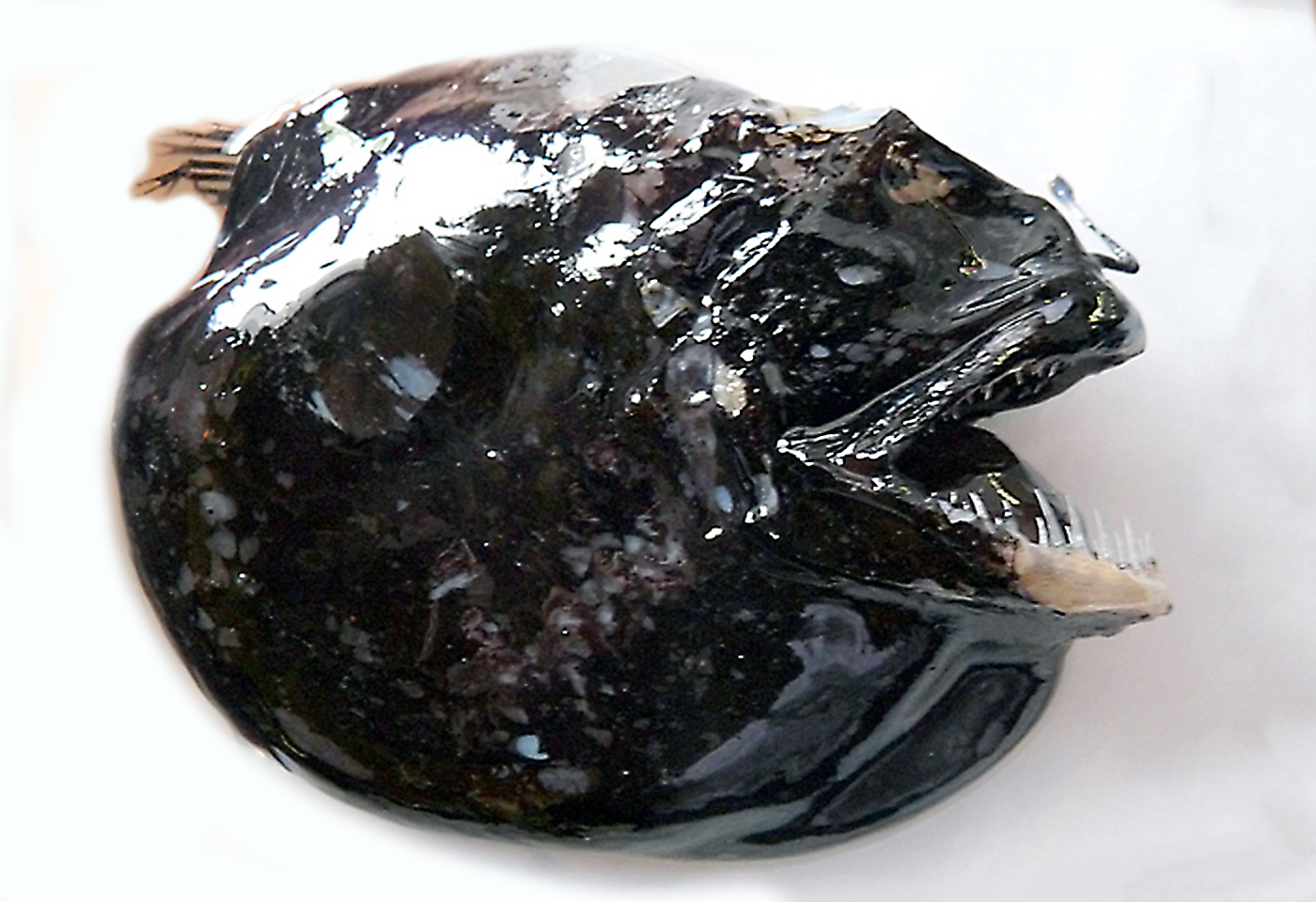Author: Keely Cook (updates were added in 2024)
Scientific name: Chaenophryne sp. (Likely Chaenophryne melanorhabdus)
Etymology: chaeno “gape”, phryne “toad” and melanos “black”, rhabdus “rod”
Size range: maximum standard length is 10.2cm (4in). Based on 14 specimens collected off Vancouver Island length was 3.7cm (1.5in) to 16.8cm (6.6in) with an average of 7.1cm (2.8in).
Identifying Features: Known as one of the “ugliest creatures identified,” the Smooth Dreamer has a massive head with a gigantic, crescent-shaped mouth that is filled with sharp, translucent teeth angled inwards to prevent prey from escaping. Smooth Dreamers are a deep-sea anglerfish. They are black blending in with the dark depths of the sea. Similar to other anglerfish there is a significant sexual dimorphosism seen in the metamorphosed adults. The females have a long dorsal spine (the illicium) with a luminous ball of flesh (the esca, also refered to the lure or bait) between the eyes, which gives off a blue-green glow to lure prey in. The pectoral fins resemble a hand, which makes the fish look like it’s “wobbling” instead of swimming normally. In addition to the location the fish was obtained, the number of rays on the fins, it is often the esca (lure) that is used for a positive identification of the deep-see angler fish. Similar to other angler-fish the males are very small compared to the females. The males are born with olfactory organs that can detect the scent of females whom they can mate with.

Ted Pietsch, a specialist in anglerfish at the University of Washington, positively identified this specimen as Chaenophryne, most likely C. melanorhabdus. Based on collections, of which Archipelago Marine Research was a part of, this is the species of Chaenophryne most often collected off of Vancouver Island which supports that it is C. melanorhabdus (Weil, Jacob & Hanke, G & Gillespie, Graham & Fong, K & Boutillier, James & Bedard, J & Riley, J. (2015)
Photo by D. Young (specimen provided by Archipelago Marine Research Ltd.).
Habitat: Chaenophryne malanorhabdus is found in the Eastern Pacific from British Columbia, the Gulf of Panama to Peru. There have been 14 specimens collected west of Vancouver Island, British Columbia between 1968 and 2004 indicating it is often in these waters, but it hasn’t been found north of Vancouver Island. The maximum depth that 10 specimens were collected ranged from 692m (2,270ft) to 1,974m (6,476ft) with an average of 1,123m (3,684ft). They have adapted to living under the extreme pressures of these depths were this is little to no light.
Prey: The Smooth Dreamer is well-adapted for living in the depths. Its dorsal spine, called the illicium, is tipped with a luminous ball of flesh which attracts prey. It is a carnivorous creature whose mouth can stretch to consume prey up to twice their size. They are constantly floating, almost motionless, in the water. The only movement they are making is swinging their ball of light back and forth.

New localities of Chaenophryne melanorhabdus in British Columbia (from Weil, Jacob & Hanke, G & Gillespie, Graham & Fong, K & Boutillier, James & Bedard, J & Riley, J. (2015))
Predators: Due to the depth they are found and the cryptic nature of this species little is know of the possible predators. Being dark and floating nearly motionless in the blackness of extreme depths helps it avoid predation.
Life Cycle: Though some species of Anglerfish are parasitic this species is described as having dwarfed males but they aren’t parasitic on the females. During reproduction the dwarfed male attaches onto the female. After fertilization, the eggs hatch and the larvae have a gelatinous layer under their transparent skin that may aid in floatation. After they metamorphose when they are around 1cm long, the larvae descend into deeper water.
Thank you to Gavin Hanke of the Royal BC Museum and Ted Pietsch at the University of Washington for their assistance shedding some light on this species.
References
BBC Home (2005). Animal Fact Files, Anglerfish. Retrieved November 27th 2011 from http://www.bbc.co.uk/nature/blueplanet/factfiles/fish/angler_fish_bg.shtml
Carpenter, K.E.; Robertson, R. (2019). “Chaenophryne melanorhabdus“. IUCN Red List of Threatened Species. 2019: e.T140348039A140858978. doi:10.2305/IUCN.UK.2019-3.RLTS.T140348039A140858978.en.
Hart, J.L. (1988). Pacific fishes of Canada: Fisheries Research Board of Canada
National Geographic (2011). Anglerfish. Retrieved November 24th 2011 from http://animals.nationalgeographic.com/animals/fish/anglerfish/
Powell, Allyn & Matarese, Ann & Kendall, Arthur & Blood, Deborah & Vinter, Beverly. (1991). Laboratory Guide to the Early Life History Stages of Northeast Pacific Fishes. Copeia. 1991. 262. 10.2307/1446279.
Theodore W. Pietsch “A New Species of the Ceratioid Anglerfish Genus Chaenophryne Regan (Lophiiformes: Oneirodidae) from the Eastern Tropical Pacific Ocean,” Copeia 2007(1), 163-168, (28 February 2007). https://doi.org/10.1643/0045-8511(2007)7[163:ANSOTC]2.0.CO;2
Royal BC Museum (2011). The Anglerfish. Retrieved December 7th 2011 from http://www.royalbcmuseum.bc.ca/Natural_History/Fish.aspx?id=294
Sea and Sky (2011). The Deep Sea Anglerfish. Retrieved November 24th 2011 from http://www.seasky.org/deep-sea/anglerfish.html
Weil, Jacob & Hanke, G & Gillespie, Graham & Fong, K & Boutillier, James & Bedard, J & Riley, J. (2015). First Records and Range Extensions of Deep-Sea Anglerfishes (Families: Oneirodidae, Melanocetidae, Ceratiidae) in British Columbia, Canada. Northwestern Naturalist. 96. 10.1898/1051-1733-96.2.133.
